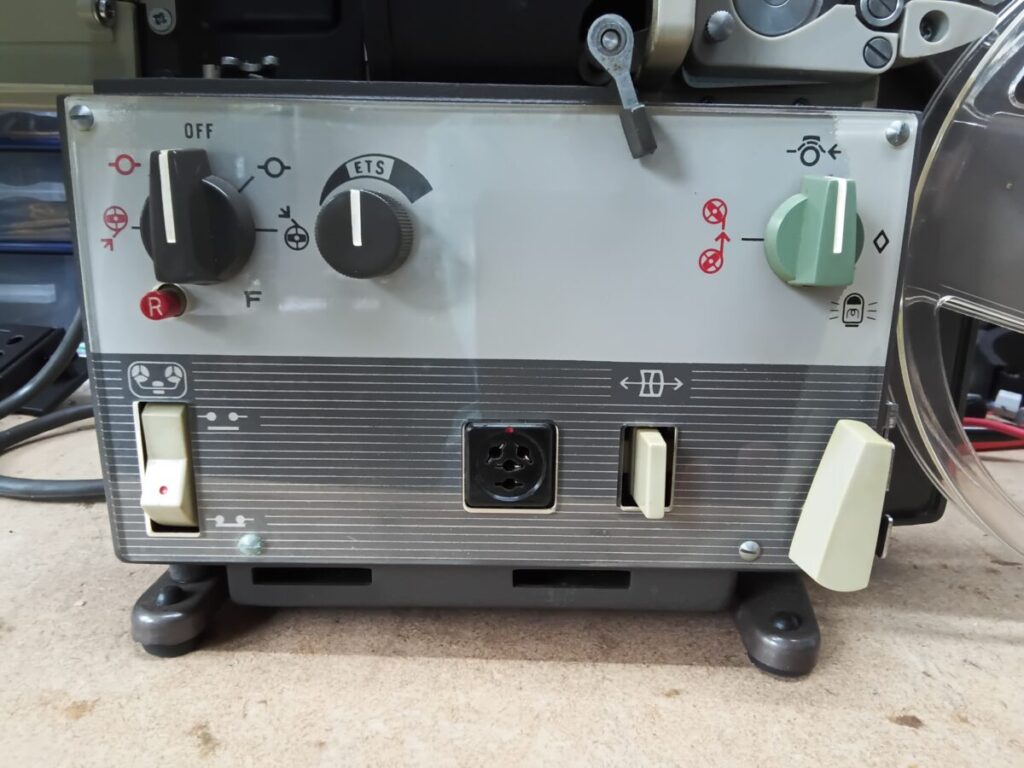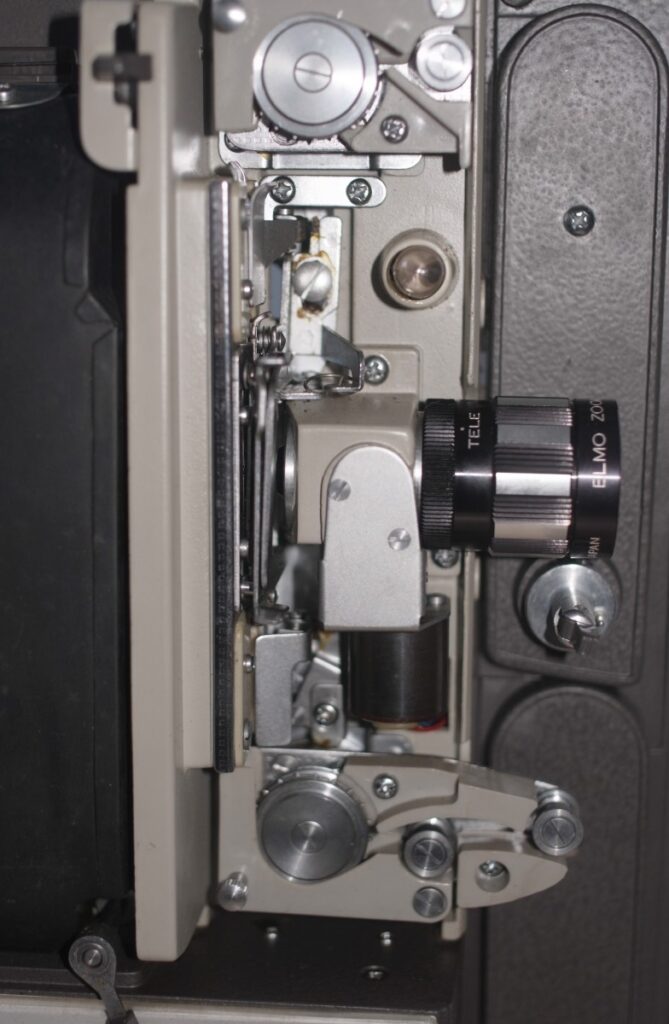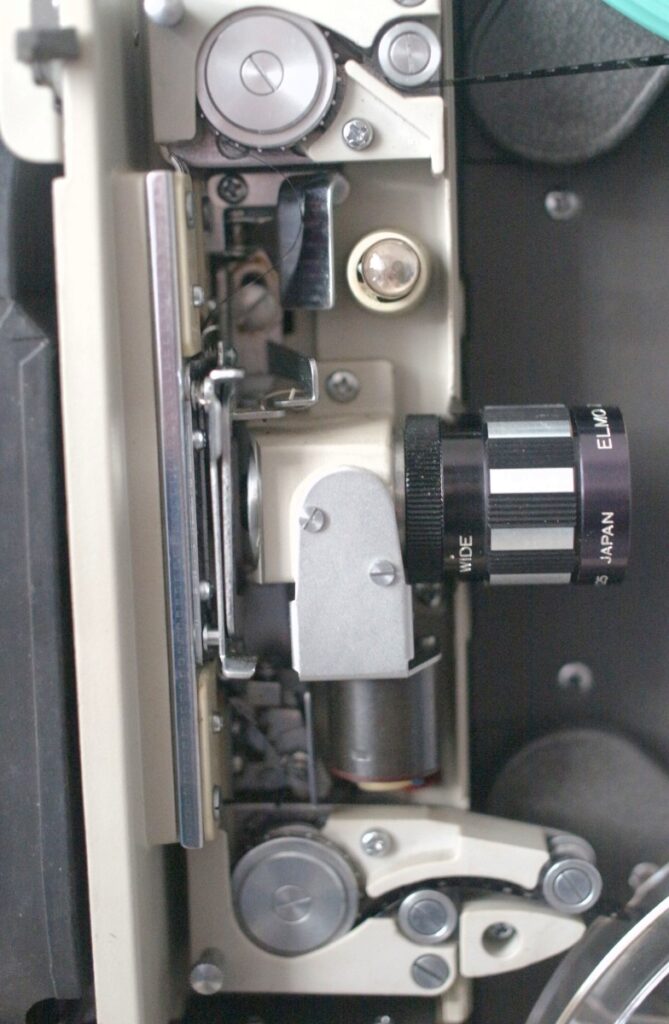The mysterious but sophisticated Elmo AP-8 cine projector
This article is about rather a mystery machine – the Elmo AP-8 cine projector which I believe was probably made in the early 1960s. Although its basic functionality is easy to fathom, there are some inputs and outputs on the unit who’s function is difficult to deduce.
About my Elmo AP-8 cine projector
I picked up my Elmo AP-8 from eBay one day last year and I bought it because it was described by the eBay seller as a standard 8 projector with sound. Now a sound projector is a relatively rare beast, but a standard 8 sound projector is even more unusual, so I placed a bid and bought it for about £25.
The unit was in reasonable condition when it turned up, although one of the pins that held the handle at the top of the machine was missing. The seller had added a note in the packaging warning that the handle wouldn’t support the weight of the projector, which I though was quite reasonable of them. Although I don’t have an original pin the fit in the handle, it was quite easy to just use a nut and bolt to get the handle patched.
On closer inspection, once I’d got the back panel off the unit, the only item I found that was broken was a suppression capacitor across the mains input which had quite spectacularly blown. I suspect that would have made quite a loud bang, which could be one of the reasons the unit was sold as ‘untested’. Anyway, I found a suitable vintage capacitor in my spares box so it was a relatively simple repair.
I needed to fit a mains plug to the lead that powers the projector, and I fitted a 3 amp fuse to the plug which should be adequate for a projector with a 150 Watt lamp.
As can be seen from the photos that follow, the unit is an upright design, and I found it to be just about complete with an Elmo Auto Reel take up reel fitted in the case and an 0.8 to 1.25 x zoom lens fitted in the lens holder. Along with the Elmo E-80 I own, this becomes the second Elmo unit in my small projector collection.
Pictures of the Elmo AP-8 projector
- Projector with arms closed
- Projector with arms extended
- Lamp housing open
- Controls of the Elmo AP-8
- Projection Lamp
- Film path
- Inside the back cover
- Replacement mains filter
- Back cover removed
- Back panel socket
Description of the Elmo AP-8 cine Projector
The Elmo AP-8 is certainly a complex and sophisticated cine projector, but I’m pretty sure it’s not a sound projector – or at least I don’t think it’s a projector capable of playing standard 8 films with a sound track.
There is very little information on-line about this unit so I suspect that not a great number were sold. Possibly it’s a little too over engineered because the mechanics of the unit seem to be really quite complex and the user controls also seem to be not too well thought out.
In terms of design the Elmo AP-8 is certainly a top of the range unit with lots of features. For example, the mains lead is held within the unit in a drum and can be pulled out of the body to be plugged in. There is then a handle on the side of the unit that winds the mains cable back into the body when the projection session is complete.
Another thing that points to the quality of the unit is the price it sold for, which a contemporary advert suggests was just over £71 in 1965. That equates to about £1700 in 2024 which places the AP-8 in the luxury class.
The unit can project forwards or reverse and there is a speed control (marked ETS) that can be used to set the forward or reverse projection speed. There is also a stop frame function, that seems to work remarkably well.
The one article I did find here suggests that the AP-8 had quite sophisticated remote control facilities and could be remotely focused.

This seems to be correct because although I don’t have the remote control, there is certainly a small motor fitted under the lens which would perform this function. There is also a leaver on the main control panel (shown here next to the input socket) which looks as if it has an icon signifying focus adjustment.
I imagine that the socket is where the remote control is plugged, and the electronic focus control next to the socket is the projector’s local focus setting control.
Although I initially thought the lever didn’t do anything because I couldn’t see any change happening when I moved the lever, I discovered that once the projector is running and showing a film the lever does indeed adjust the focus. I didn’t discover this until I’d run a few films through the projector and then noticed the focus wandering, and I found my elbow was pressing the lever!
On the back of the unit, behind a small flap is another set of two sockets. One is a single pin socket, and the other has four pins. Although I don’t know for sure what these are for, I wonder if they are to control a tape recorder so that sound can be synchronised with a playing film?
I know projectors were made with tape control mechanisms, where the tape would be looped through the device on the projector and the tape recorder playback speed would be controlled by the projector and I wonder if this is a similar type of arrangement. One clue which leads me to wonder this is the small rocker switch on the projector control panel which has an icon above it showing two tape reels.
When this rocker switch is pressed down, the projector stops working completely, and I wonder if the socket on the back should be connected to a tape recorder (or Elmo Tape recorder add on accessory) that controls the projector. This is of course all conjecture because without the manual I can’t actually tell what these controls do.
Projector Operation
The operation of the AP-8 seems overly complex.
There are two controls that need to be set to actually project a film – the main control to the left of the control panel needs to be turned clockwise to project the film forwards or anti-clockwise to project it backwards. There is a small red button that needs to be pressed to select the backwards option. This control has two positions, the first starts the motor running and then the second actually engages the film transport.
The second control to the right then needs to be turned in order to turn on the lamp and project the film. However, the control also has two positions – the first position seems to set up the film path to form the loops that the film needs to go through in order for the film gate to work properly1.
I’ve never seen another projector that has this option where the film loops are not basically in place all the time. I’m not sure what advantage there is to doing this, but Elmo obviously put a lot of engineering into making this work.
The images in the gallery above show this action, although it is not easy to see the film in the photos.
Video of the Elmo AP-8 running
The video below was taken whilst I was evaluating the Elmo AP-8 on my bench in the workshop so it’s not a very polished video but it does show the basic operation and how quietly it runs.
Elmo AP-8 Specifications
- Elmp AP-8 Standard 8 cine projector
- Made in the early 1960s2
- Original purchase price £71-7-6 equivalent to over £1700 in 2024
- Forward or Reverse projection
- Electronic focusing control
- 150W Lamp
- Auto load of film
- Heat shield automatically protects the film when in stationary mode
- Zoom lens with wide, normal and telephoto positions
- Safety switch disconnects the power when the back case is removed
My evaluation of the Elmo AP-8
So, what is my evaluation of the Elmo AP-8. Well, I’d say that it is obviously a well made and sophisticated film projector. That’s not really surprising because Elmo were one of the best projector manufacturers so I wouldn’t expect anything else, but this is an exceptional machine but it’s also an enigma.
It seems thoroughly over engineered to just project films, but without knowing what was in the mind of the designers and what particular problem they were trying to address it’s difficult to judge how well they have done. It can’t have been a very successful model because there is almost no information about it on the web, I’ve never seen another on on eBay, and I can’t even find the handbook, or at least I can’t find on on the free manual sites (it’s possible to buy one for £10 but that seems too much to me for a photocopy).
If anyone who reads this has knowledge of this projector, or used to own one please let me know and I’ll update it to remove any false information.
- In all projectors the film is not moved smoothly through the gate, but rather pulled down a frame at a time so the projector needs to have a loop before this pulling action otherwise the film would be torn [↩]
- The advert I found was from 1965 so this unit was probably made in 1963 03 1964 [↩]
Discover more from Everything Vintage
Subscribe to get the latest posts sent to your email.














